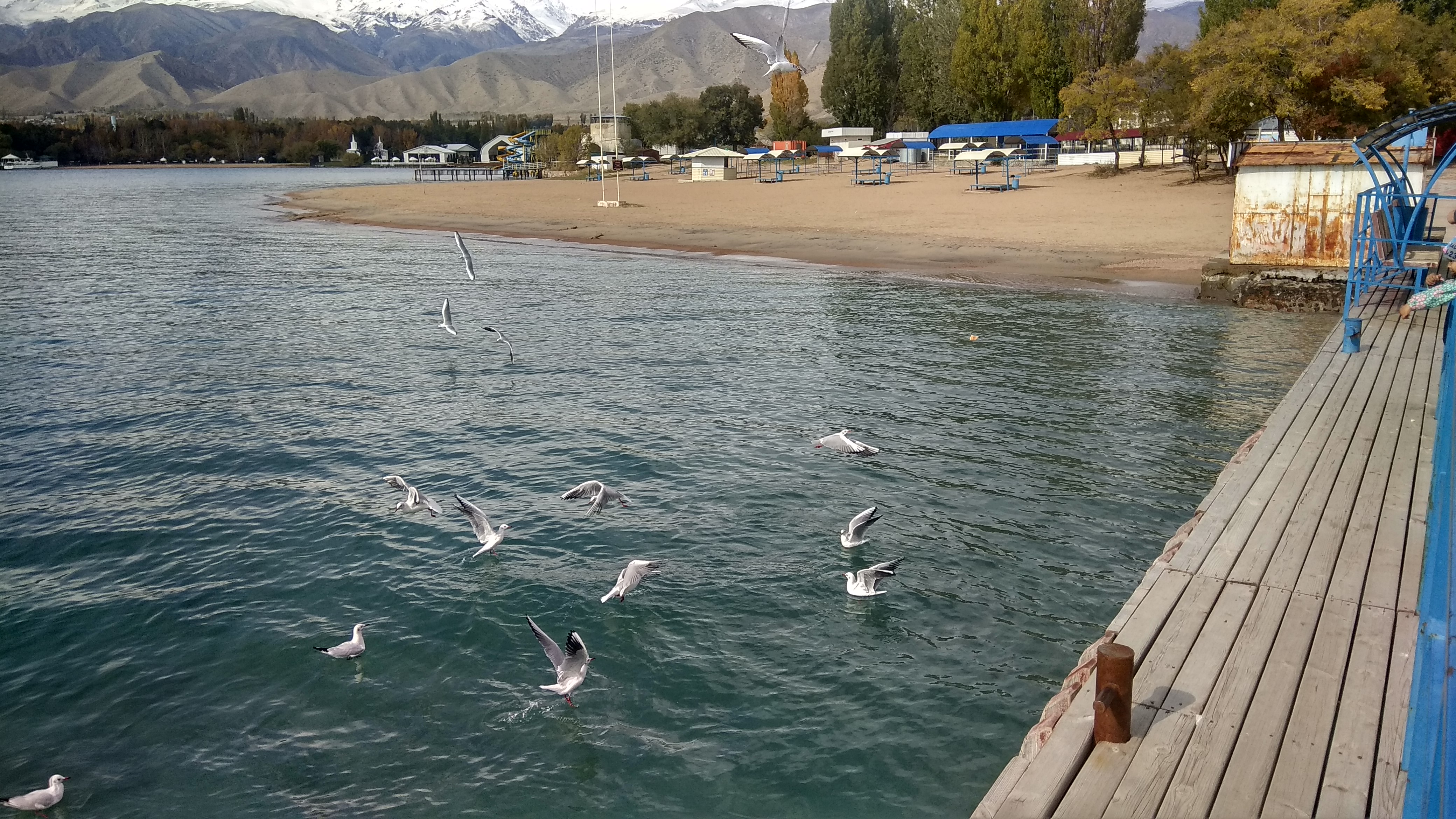|
Issyk Lake
The Lake Issyk also known as Issyk Lake ( kz, Есік көлі, ''Esık kölı'') is a lake in Kazakhstan fed by the Issyk River. It should not be confused with the Issyk-Kul Lake in neighboring Kyrgyzstan. History It is estimated that the lake was formed about 8-10 millennia ago, as a result of a catastrophic earthquake that caused the collapse of the right slope of the gorge. After the collapse, debris blocked the gorge and created a dam about 300 meters tall. A lake formed behind the dam was about 1,850 meters long, 500 meters wide and 50 to 79 meters deep, located at an altitude of 1,756 meters. The lake became known in Russia and Europe by the middle of the 19th Century, after the formation of the village of Nadezhdinskaya at the mouth of the gorge. One of the first researchers was the geographer Semenov Tien-Shansky, who mentioned the lake in his diaries: "we were delighted to see at our feet the "Green lake" (in Kazakh "Jasyl-Kol"), which had the purest and most transparen ... [...More Info...] [...Related Items...] OR: [Wikipedia] [Google] [Baidu] |
Lake
A lake is an area filled with water, localized in a basin, surrounded by land, and distinct from any river or other outlet that serves to feed or drain the lake. Lakes lie on land and are not part of the ocean, although, like the much larger oceans, they do form part of the Earth's water cycle. Lakes are distinct from lagoons, which are generally coastal parts of the ocean. Lakes are typically larger and deeper than ponds, which also lie on land, though there are no official or scientific definitions. Lakes can be contrasted with rivers or streams, which usually flow in a channel on land. Most lakes are fed and drained by rivers and streams. Natural lakes are generally found in mountainous areas, rift zones, and areas with ongoing glaciation. Other lakes are found in endorheic basins or along the courses of mature rivers, where a river channel has widened into a basin. Some parts of the world have many lakes formed by the chaotic drainage patterns left over from the la ... [...More Info...] [...Related Items...] OR: [Wikipedia] [Google] [Baidu] |
Kazakhstan
Kazakhstan, officially the Republic of Kazakhstan, is a transcontinental country located mainly in Central Asia and partly in Eastern Europe. It borders Russia to the north and west, China to the east, Kyrgyzstan to the southeast, Uzbekistan to the south, and Turkmenistan to the southwest, with a coastline along the Caspian Sea. Its capital is Astana, known as Nur-Sultan from 2019 to 2022. Almaty, Kazakhstan's largest city, was the country's capital until 1997. Kazakhstan is the world's largest landlocked country, the largest and northernmost Muslim-majority country by land area, and the ninth-largest country in the world. It has a population of 19 million people, and one of the lowest population densities in the world, at fewer than 6 people per square kilometre (15 people per square mile). The country dominates Central Asia economically and politically, generating 60 percent of the region's GDP, primarily through its oil and gas industry; it also has vast mineral ... [...More Info...] [...Related Items...] OR: [Wikipedia] [Google] [Baidu] |
Issyk River
The Issyk ( kk, Есік, lit=hot, translit=Esik) is a river in Kazakhstan that crosses the Issyk Lake (not to be confused with the much greater Issyk Kul Lake in Kyrgyzstan) and the town of Esik. It is a tributary of the river Ili. One of the largest rivers on the northern slope of the , its headwaters come from 32 active glaciers that cover an area of . The largest glaciers are the Zharsai with an exposed length of and an area of , the Grigoriev with a lengt ... [...More Info...] [...Related Items...] OR: [Wikipedia] [Google] [Baidu] |
Issyk Kul
Issyk-Kul (also Ysyk-Köl, ky, Ысык-Көл, lit=warm lake, translit=Ysyk-Köl, , zh, 伊塞克湖) is an endorheic lake (i.e., without outflow) in the Northern Tian Shan mountains in Eastern Kyrgyzstan. It is the seventh-deepest lake in the world, the tenth-largest lake in the world by volume (though not in surface area) and the second-largest saline lake after the Caspian Sea. Issyk-Kul means "warm lake" in the Kyrgyz language; although it is located at a lofty elevation of and subject to severe cold during winter, it never freezes. The lake is a Ramsar site of globally significant biodiversity and forms part of the Issyk-Kul Biosphere Reserve. Geography Issyk-Kul Lake is long, up to wide and its area is . It is the second-largest mountain lake in the world behind Lake Titicaca in South America. It is at an altitude of and reaches in depth. About 118 rivers and streams flow into the lake; the largest are the Jyrgalang and Tüp. It is fed by springs, including many ... [...More Info...] [...Related Items...] OR: [Wikipedia] [Google] [Baidu] |
Kyrgyzstan
Kyrgyzstan,, pronounced or the Kyrgyz Republic, is a landlocked country in Central Asia. Kyrgyzstan is bordered by Kazakhstan to the north, Uzbekistan to the west, Tajikistan to the south, and the People's Republic of China to the east. Its capital and largest city is Bishkek. Ethnic Kyrgyz make up the majority of the country's seven million people, followed by significant minorities of Uzbeks and Russians. The Kyrgyz language is closely related to other Turkic languages. Kyrgyzstan's history spans a variety of cultures and empires. Although geographically isolated by its highly mountainous terrain, Kyrgyzstan has been at the crossroads of several great civilizations as part of the Silk Road along with other commercial routes. Inhabited by a succession of tribes and clans, Kyrgyzstan has periodically fallen under larger domination. Turkic nomads, who trace their ancestry to many Turkic states. It was first established as the Yenisei Kyrgyz Khaganate later in the ... [...More Info...] [...Related Items...] OR: [Wikipedia] [Google] [Baidu] |
Caspian Tiger
The Caspian tiger was a ''Panthera tigris tigris'' population native to eastern Turkey, northern Iran, Mesopotamia, the Caucasus around the Caspian Sea, Central Asia to northern Afghanistan, and the Xinjiang region in western China. Until the Middle Ages, it was also present in Ukraine and southern Russia. It inhabited sparse forests and riverine corridors in this region until the 1970s. This population was regarded as a distinct subspecies and assessed as extinct in 2003. Results of a phylogeographic analysis evinces that the Caspian and Siberian tiger populations shared a common continuous geographic distribution until the early 19th century. Some Caspian tigers were intermediate in size between Siberian and Bengal tigers. It was also called Balkhash tiger, Hyrcanian tiger, Turanian tiger, and Mazandaran tiger ( fa, ). Taxonomy ''Felis virgata'' was a scientific name used by Johann Karl Wilhelm Illiger in 1815 for the greyish tiger in the area surrounding the Caspian Sea ... [...More Info...] [...Related Items...] OR: [Wikipedia] [Google] [Baidu] |
Pyotr Semyonov-Tyan-Shansky
Pyotr Petrovich Semyonov or Semenov (russian: Пётр Петрович Семёнов; 2 January ''(New style: 14 January)'', 1827 – 26 February ''(New style: 11 March)'', 1914) was a Russian geographer and statistician who managed the Russian Geographical Society for more than 40 years. He gained international fame for his pioneering exploration of the Tian Shan mountains. He changed his surname to "Semyonov of Tian Shan" (Семёнов-Тян-Шанский, ''Semyonov-Tyan-Shansky'') at the age of 79. Several of his descendants, including a son, Andrey Semyonov-Tyan-Shansky, and a grandson Oleg Semenov-Tian-Shansky became scientists of note. Life Pyotr Semenov was born into a noble family and studied at Saint Petersburg University. Together with Fyodor Dostoyevsky, Semenov attended secret meetings of the "Petrashevsky Circle" (a literary discussion group of progressive-minded commoner-intellectuals in St. Petersburg). During the 1850s he studied geography and geolo ... [...More Info...] [...Related Items...] OR: [Wikipedia] [Google] [Baidu] |
Flood
A flood is an overflow of water ( or rarely other fluids) that submerges land that is usually dry. In the sense of "flowing water", the word may also be applied to the inflow of the tide. Floods are an area of study of the discipline hydrology and are of significant concern in agriculture, civil engineering and public health. Human changes to the environment often increase the intensity and frequency of flooding, for example land use changes such as deforestation and removal of wetlands, changes in waterway course or flood controls such as with levees, and larger environmental issues such as climate change and sea level rise. In particular climate change's increased rainfall and extreme weather events increases the severity of other causes for flooding, resulting in more intense floods and increased flood risk. Flooding may occur as an overflow of water from water bodies, such as a river, lake, or ocean, in which the water overtops or breaks levees, resulting ... [...More Info...] [...Related Items...] OR: [Wikipedia] [Google] [Baidu] |
Esik
Esik ( kz, Есік (''Esık''), also spelled ''Issyk'', ''Yesik'' and ''Yesyk'') is a town in Almaty Region of Kazakhstan, the administrative center of Enbekshikazakh District. It is located on the Issyk River, at the foot of the Tian Shan, 53 km east of Almaty and 112 km over the mountains from Issyk Kul Lake. Population: It was founded by Cossacks in 1858 as stanitsa Nadezhdinskaya. The Issyk kurgan of the famous "Golden Man" is nearby. The nearby Issyk Lake (not to be confused with the much greater Issyk Kul Lake in Kyrgyzstan) is mostly famous for the way it was created (as a result of an ancient natural landslide damming a valley), destroyed (another natural landslide destroying that dam in 1963, with a subsequent damage to the city of Esik as well), and re-created (with human help). Enterprises There are large enterprises such as "Koktem", "Esik Wine Factory", "Dionys", "Eles", "FoodMaster","Gold Produkt". In addition, construction, transport, etc. institu ... [...More Info...] [...Related Items...] OR: [Wikipedia] [Google] [Baidu] |
Lakes Of Kazakhstan ...
Excluding the northernmost districts, Kazakhstan consists of endorheic basins, where rivers flow into one of the numerous lakes. The most important drainage system is known as Yedisu, meaning "seven rivers" in Turkic languages. Below is the list of the more important lakes, some of which are shared (Caspian Sea, Lake Aral, Lake Aike, etc.) with the neighbouring countries. References {{Europe topic, List of lakes of * Lakes Kazakhstan Kazakhstan, officially the Republic of Kazakhstan, is a transcontinental country located mainly in Central Asia and partly in Eastern Europe. It borders Russia to the north and west, China to the east, Kyrgyzstan to the southeast, Uzbeki ... [...More Info...] [...Related Items...] OR: [Wikipedia] [Google] [Baidu] |




